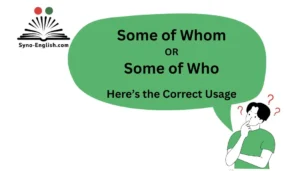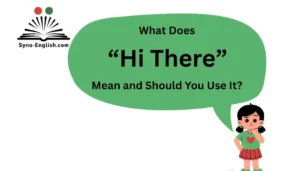When it comes to greetings, few words carry such a unique tone as Hi There, setting the stage for a friendly conversation that reflects both intention and experience. This phrase often sparks curiosity, bridging relationships between friendly and professional circles. In English, the expression feels casual, playful, and even slightly flirty depending on the settings. I’ve seen how a simple “Hi There” can create a natural connection without crossing boundaries, making every exchange feel more human and open.
As a language learner turned writer, I’ve often reflected on its meaning and history. My blog once explored how people use or avoid certain expressions based on how they’re perceived. The modern usage of “Hi There” has evolved with time-it now fits both social chats and light workplace communication. A speaker’s tone and cultural context truly shape how this greeting lands, showing how deeply communication style affects understanding.
The Origins and Evolution of “Hi There”
Everyday phrases often have fascinating histories. To understand the meaning of “Hi There”, we need to look at the origins of both “Hi” and “There.”
- “Hi”: The word “hi” emerged in English in the 15th century, derived from exclamations like “hey” and “hoy.” By the 19th century, it became one of the most common casual greetings in American English.
- “There”: The word “there” has Old English roots (“þær”), originally indicating location or presence. Over time, it began to function not only as a directional term but also as a conversational softener.
When combined, “Hi There” became a friendly call to someone’s attention. Instead of just saying “Hi,” adding “there” made the greeting feel warmer, less abrupt, and more personal.
Influence of Popular Culture
The phrase spread widely in the 20th century through Hollywood films, TV shows, and songs. Characters often greeted each other with “Hi there!” to sound approachable and informal. This helped cement it as a go-to phrase in casual American speech.
What “Hi There” Really Means
At first glance, “Hi There” looks like a simple combination of two words. But in communication, even small additions change meaning.
- Literal meaning: “Hi” = hello, greeting. “There” = location, presence. Together: a greeting directed toward someone present.
- Pragmatic meaning: The phrase signals friendliness, approachability, and casualness.
- Psychological effect: “There” adds warmth. A simple “Hi” can feel curt; “Hi There” softens the interaction and makes it feel like you’re really addressing the other person.
Differences in Perception
- Native English speakers: Usually interpret “Hi There” as warm and casual, sometimes flirty, depending on tone.
- English learners: May feel unsure – is it formal enough? Is it sarcastic? Understanding the cultural nuance is key.
Quote: Linguist Deborah Tannen notes that “small talk is not small at all; it is a crucial way of negotiating relationships.” Greetings like “Hi There” fit exactly into this category.
How “Hi There” Is Used in Everyday English
You’ll hear or read “Hi There” across many situations – spoken, written, and digital.
Common Spoken Situations
- Meeting a friend casually: “Hi there, how’s it going?”
- Greeting a stranger politely: “Hi there, can I help you find something?”
- Lighthearted surprise: “Oh, hi there! Didn’t see you come in.”
Written Communication
- Text messages: Casual opener when chatting with friends.
- Emails: Sometimes used in semi-formal workplace emails, but risks sounding too casual.
- Social media: Often used by brands trying to sound friendly and approachable.
Examples in Context
| Scenario | Greeting Example | Tone |
| Friend at café | “Hi there, you’re early!” | Friendly |
| Customer in the store | “Hi there, welcome in.” | Polite/Neutral |
| Text to crush | “Hi there 😉” | Flirty |
| Work email | “Hi there, team!” | Casual/Approachable |
Notice how tone, context, and punctuation change the meaning drastically.
When and Where to Use “Hi There”
The key to using “Hi There” is knowing where it fits.
Suitable Settings
- Casual conversations with friends, family, or peers.
- Social gatherings where informality is expected.
- Informal business communication (team chats, internal updates).
- Customer-facing roles where warmth matters (retail, hospitality).
Settings to Avoid
- Job interviews: Too casual for first impressions.
- Formal business emails: “Dear [Name]” or “Hello” is safer.
- Academic writing or official correspondence: Always use formal greetings.
Cross-Cultural Perceptions
- American English: Widely accepted, casual but not rude.
- British English: Sometimes seen as overly informal or slightly quirky.
- Asian workplaces: Often too casual – formal greetings are preferred.
Case Study: U.S. vs. Japan
- In the U.S., customer service staff often greet with “Hi there, how can I help?”
- In Japan, a formal “Irasshaimase” (Welcome) is expected instead. Using “Hi there” would feel unprofessional.
Informal vs. Formal Greetings: Understanding the Nuances
Every greeting sets a tone. Compare “Hi There” to other common greetings:
| Greeting | Formality Level | Typical Usage | Impression |
| Hi There | Casual | Friends, casual workplace, retail | Warm, informal |
| Hello | Neutral | General-purpose | Polite, safe |
| Good Morning | Formal | Workplace, business, formal events | Respectful |
| Hey | Very casual | Friends, peers | Relaxed, youthful |
| Dear [Name] | Formal | Emails, letters | Professional, distant |
Key insight: Choosing the wrong greeting can make you seem too stiff or too casual. “Hi there” works when you want friendliness without formality.
“Hi There” in Professional and Digital Communication
Workplace communication has changed dramatically with digital tools like Slack, Microsoft Teams, and Zoom. Greetings have adapted too.
Workplace Emails
- Safe option: “Hello [Name],”
- Risky option: “Hi there,” – may come across as unprofessional in first contact emails.
Internal Chats
- In team chats, “Hi there!” feels friendly and is often appreciated.
- Good for breaking the ice in group discussions.
Marketing and Branding
Brands often use “Hi there” in newsletters or pop-ups. Example:
- Spotify: “Hi there! Ready for your personalized playlist?”
- Airbnb: “Hi there, welcome back to your next adventure.”
This works because brands aim to sound approachable, not stiff.
Warning: Overusing it can sound forced or robotic
Responding to “Hi There”
How should you reply when someone greets you with “Hi there”?
Friendly Replies
- “Hey! How are you?”
- “Hi there, good to see you!”
Neutral/Professional Replies
- “Hello, thanks for reaching out.”
- “Hi, how can I help you today?”
Flirty Replies
- “Well, hi there, stranger 😉”
- “Hi there… I was just thinking about you.”
Tips for English Learners
- Match the tone. If it’s formal, reply formally.
- Don’t overthink – a simple “Hi” or “Hello” works fine.
- Add context if needed: “Hi there, nice to meet you.”
Is “Hi There” Flirty or Just Friendly?
This is one of the biggest questions about the meaning of “Hi There.”
Friendly Use
- With friends, family, and coworkers in casual contexts.
- Often accompanied by a smile or relaxed tone.
Flirty Use
- Tone of voice, eye contact, or emojis can turn it flirty.
- “Hi there 😉” is a clear sign of flirtation.
- Often used as a playful opener in dating apps.
Social Media and Texting
- Adding emojis (😊😉😏) changes interpretation.
- Without context, the written “Hi there” can be ambiguous.
Tip: Pay attention to tone and relationship – it’s not the phrase alone, but how it’s delivered.
Alternatives to “Hi There”
Sometimes you need a variation. Here are alternatives:
Friendly Alternatives
- “Hey!”
- “Hello there!”
- “Hi!”
Professional Alternatives
- “Good morning/afternoon.”
- “Hello [Name].”
- “Greetings.”
Choosing the Right One
| Situation | Best Greeting |
| First business email | “Hello [Name]” |
| Team chat | “Hi there, team!” |
| Friend message | “Hey!” |
| Formal event | “Good evening.” |
Conclusion
The phrase Hi There may appear simple, but it carries layers of meaning that go beyond a basic greeting. Its tone can shift from friendly to professional, playful to polite, depending on the intention behind it. In today’s modern communication, where text and voice often replace face-to-face interaction, this small phrase helps build warmth and approachability. Using Hi There with the right awareness of context, relationship, and setting shows emotional intelligence and linguistic sensitivity. It signals openness, friendliness, and a readiness to connect while maintaining respect for boundaries.
Over time, the usage of “Hi There” has evolved, becoming a bridge between language learners, professionals, and writers seeking genuine connection. It reflects how communication styles adapt with culture, technology, and personality. Choosing this greeting effectively depends on tone and situation – sometimes it’s the best choice to spark a positive conversation, while at other times, more formal words work better. In any case, understanding its meaning and impact can help us communicate with clarity and charm, making even the simplest words powerful tools of connection.
FAQs
What does “Hi There” mean?
It’s a friendly and casual greeting used to start a conversation warmly.
Is “Hi There” professional?
It depends on the tone and setting; in casual work contexts, it’s acceptable.
Can “Hi There” sound flirty?
Yes, its perceived intention and tone may seem flirty in informal chats.
Should I use “Hi There” in emails?
Yes, if your email is informal or creative, it adds a personal touch.
How is “Hi There” different from “Hello”?
“Hi there” feels more casual, while “Hello” is neutral and formal.
Why do people like using “Hi There”?
It feels friendly, warm, and invites connection instantly.
Is “Hi There” okay for new acquaintances?
Yes, it breaks the ice without sounding overly formal.
How do I know when to avoid it?
Avoid it in official or serious communication requiring formality.
What’s the origin of “Hi There”?
It’s part of English colloquial speech that became popular over time.
Does “Hi There” work across cultures?
Yes, but context matters-some cultures prefer more polite greetings




